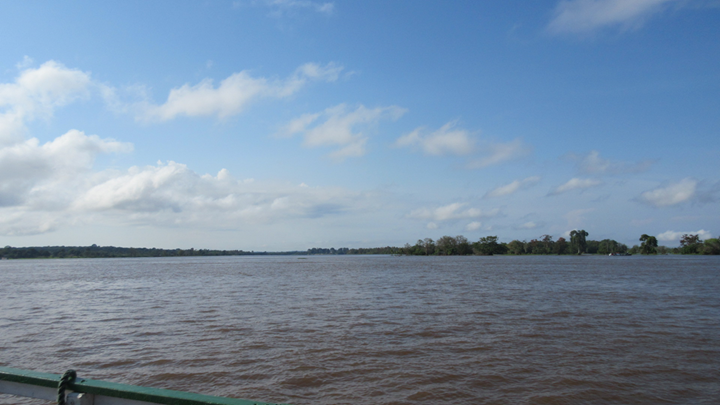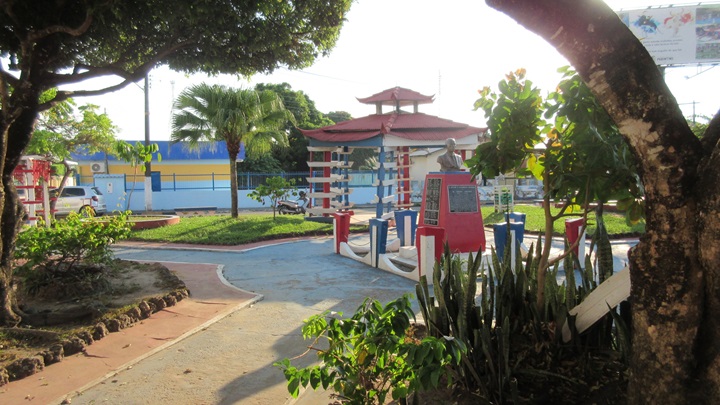Interview With Visiting Fellow Facundo Garasino: A Transnational History of Migrants Connecting Japan and South America
2025.07.25
“A Transnational History of Japanese Emigration to South America: Migration Programs, Economic Development, and Cultural Activities ” is a research project that started in 2021 at the JICA Ogata Sadako Research Institute for Peace and Development (JICA Ogata Research Institute). A book that compiles findings from this project will be published soon. We asked Visiting Fellow Facundo Garasino, who has played a central role in this research project, about the real thrill of migration studies, his passion in his research work and his future prospects.

─ What first made you interested in the field of migration studies?
I am from Buenos Aires, Argentina, where Japanese culture is popular. I grew up watching a lot of Japanese anime. Wanting to know more about the culture, I started to study Japanese from the age of 14 in community classes offered by the University of Buenos Aires. In Japan, the Nikkei (Japanese migrants and their descendants) who have settled in Brazil may be better known than the Nikkei in Argentina, but the number of the latter is large as well. I was familiar with the Nikkei because the teacher who taught me Japanese was also a Nikkei and traditional Japanese festivals were held in my country.
This experience made me want to study at a university in Japan, and in 2008, I came to Japan on a government-sponsored scholarship. I started to become interested in migration studies and was eager to study the connection between Japan and the outside world. I therefore went to Osaka University where academic work in Japanese studies is active. I stayed on to attend graduate school there. Studies on Japan that have research frameworks that connect Latin America with Japan, are not common compared to research frameworks that compare Asia or Western Europe against Japan. I have been continuing my academic work to date with the objective of re-examining the society, culture and history of Japan through migration history.
─ Can you tell us about the research project that you launched when you joined the JICA Ogata Research Institute?
While at graduate school, I saw an advertisement for an open position for a researcher to work on migration studies at the JICA Ogata Research Institute. I applied as this was a perfect match with my area of study. After I was accepted, I launched the research project “A Transnational History of Japanese Emigration to South America: Migration Programs, Economic Development, and Cultural Activities .” JICA was born following the merger of various organizations and one of these predecessors was Japan Emigration Service (JEMIS), the agency that operated national programs to promote the emigration of Japanese nationals after World War II (WWII). What roles did these programs and the activities by the Nikkei play in Japan and South America, in particular, in the formation and subsequent transformation of modern nation states? To revisit this history, we decided to work on this research project.
While emigration from Japan to South American countries continued throughout the 20th century, my work mainly focuses on the period between the late 1920s and the early 1950s. Earlier on, a large number of Japanese families emigrated as agricultural workers for coffee plantations in Brazil. When programs to send settlers to develop the Amazon region started, emigration cooperatives were formed in Japan per prefecture and some people chose to buy their own land in their destination country before emigration. This was a period when emigration from Japan to South America dynamically changed and a wide range of policies were implemented.
My research method involves going through a wide range of sources such as public documents produced by government agencies in charge of Japanese emigration policies and organizations in charge of receiving Japanese immigrants, as well as newsletters, journals, Japanese-language newspapers and private papers left by Japanese immigrants. Sometimes written sources alone aren't enough to fully grasp history. Therefore, I made visits to various parts of South America to listen to the stories of Japanese immigrants and their descendants. Through this process, I was often able to understand the specific context behind the sources and gain a better idea of the hardships the immigrants went through that were not recorded in writing.

A panoramic view of the majestic Amazon River on the way to Vila Amazonia, a former settlement of Japanese immigrants, in Amazonas, Brazil
A relief in a square in Vila Amazonia that commemorates the transplantation of jute by Japanese settlers
My most memorable experience is from when one woman shared her firsthand account of her experience with me. This woman had moved to Brazil in the early 1950s, shortly after WWII, to work on a jute farm in the Amazon basin. Jute is a fiber crop. According to her, at the time, the area suffered from one of the worst floodings to date during the rainy season. She said that the area where houses were scattered along the riverbank became completely underwater. The Japanese immigrants were unable to do anything, let alone farming, and they were completely isolated because of the flooding. She was thus hit hard by a reality that was far from being a dreamland, at a young age, and at a time when she was not fully familiar with Brazil, and was also coming to terms with her first ever trip abroad. Her pain must have been beyond our imagination.
Written sources do not often describe such gritty realities of immigration. This is because most of the existing sources were produced by those who made emigration policies and implemented emigration programs, and not much was written about the inconvenience. This experience was invaluable and made me painfully aware that there really is so much we can never know unless we listen to firsthand accounts.
─ What message do you want to convey with the book published as an outcome of this research project?
I am one of the editors of the book “A History of Japan and South America Connected by Migration” (The University of Tokyo Press; available in Japanese only), which will be published in 2025. This book looks at how migrants bridged South America and Japan from the 1920s to the post-WWII period. Referring to various cases, this book unravels the history of the Japanese migrants and the Nikkei in South America. It consists of three parts: Part 1 is titled “Emigration and Education,” and looks at the cooperation between state and non-state agents to implement schemes for emigration from Japan to South America; Part 2 is titled “Material and Cultural Flows,” and focuses on case studies involving international trade, public diplomacy, and cultural practices initiated or led by migrants; and Part 3 is titled “Migration and Development,” and looks at case studies in Hokkaido, Southern Brazil, and the Amazon region.
Although this book is primarily academic and may therefore seem challenging to general readers, there is one message I would like to convey to everyone: Japan is a country that had implemented its own emigration policies since the mid-19th century. Whenever migration is discussed in Japan, I feel that people tend to talk about it as if it is a very new topic that has emerged only recently. However, Japan was an international emigrant-sending country for more than a century, taking measures to protect and support those who emigrated from Japan. Such history is precisely why second- and third-generation Nikkei, such as those from Brazil and Peru, come to Japan, supporting various industries and playing various roles in local communities. Yet strangely enough, here in Japan, the reality is that this history is completely forgotten.

Praça Tsukasa Uyetsuka (“Tsukasa Uetsuka Plaza” in English), in Parintins, Amazonas, Brazil, opened in 1981 to celebrate the 50th anniversary of the Vila Amazonia settlement. It is often called Praça do Japonês (“Plaza of the Japanese” in English).
This is why I believe that the significance of this research project lies in how it can answer questions on the deep connection between migration issues and Japanese society. We should not consider migrants as exceptional or unusual. Upon considering how to accept immigrants and live in harmony with them on equal terms, I would like non-academic readers to have a better understanding of the significant roles played by migration policies in Japanese modern history. My further thoughts are explained in the prologue of the book. I hope you enjoy reading it.
─ What are your future prospects?
I think that I am in a unique position to build bridges between academic communities beyond national borders. While migration studies are taking place in South America, fewer people there can conduct research in Japanese as Nikkei communities now mainly consist of second and third generations. I have seen for myself that materials in Japanese that preserve the precious memories of Nikkei communities are being lost. Furthermore, the perspectives of the host society are also important in migration studies. Important works published in Spanish or Portuguese, such as studies on local Nikkei communities, are rarely referred to in Japan.
One reason is the language barrier but a bigger reason is that such studies are not always categorized as migration studies. Research findings that are published in fields other than migration studies, such as sociology, geography or history, often go unnoticed by researchers studying migration. Another barrier is the lack of collaboration among academic communities. Platforms for researchers studying migration in Japan and researchers based in South America to discuss in person are limited and there are no opportunities for them to learn about each other’s work. It is similar to how an academic paper on French literature that is written in Japanese unfortunately cannot be expected to have many opportunities to be referred to in France.
Migrants exist across multiple countries, that is, the sending countries and receiving countries. This is why it is important to attempt to link and describe history beyond national borders. Using my ability in both Spanish and Japanese, I would like to continue to study migrant communities while assisting academic communities to make migration studies themselves more transnational.

事業事前評価表(地球規模課題対応国際科学技術協力(SATREPS)).国際協力機構 地球環境部 . 防災第一チーム. 1.案件名.国 名: フィリピン共和国.

事業事前評価表(地球規模課題対応国際科学技術協力(SATREPS)).国際協力機構 地球環境部 . 防災第一チーム. 1.案件名.国 名: フィリピン共和国.

事業事前評価表(地球規模課題対応国際科学技術協力(SATREPS)).国際協力機構 地球環境部 . 防災第一チーム. 1.案件名.国 名: フィリピン共和国.

事業事前評価表(地球規模課題対応国際科学技術協力(SATREPS)).国際協力機構 地球環境部 . 防災第一チーム. 1.案件名.国 名: フィリピン共和国.

事業事前評価表(地球規模課題対応国際科学技術協力(SATREPS)).国際協力機構 地球環境部 . 防災第一チーム. 1.案件名.国 名: フィリピン共和国.
scroll